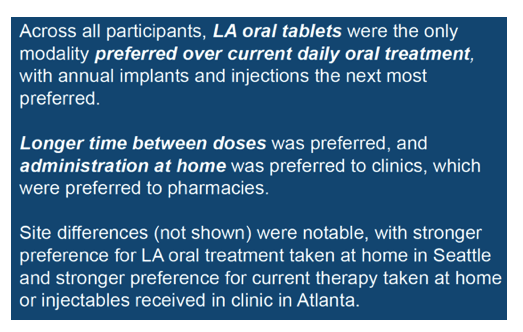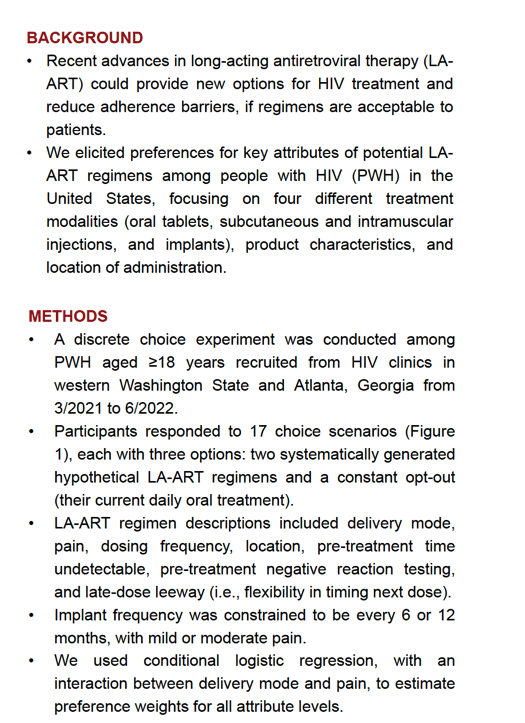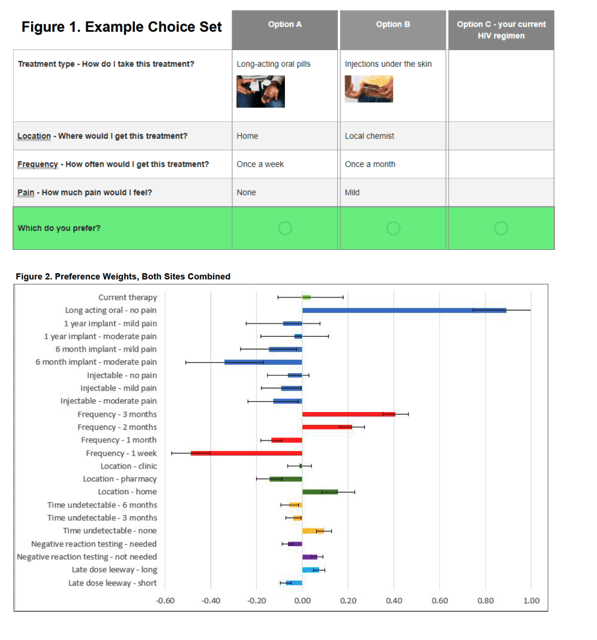 |
 |
 |
| |
US PATIENT PREFERENCES FOR LONG-ACTING HIV
TREATMENT: A DISCRETE CHOICE EXPERIMENT
|
| |
| |
CROI 2023 Feb 20-23
Susan M. Graham,1 Douglas Barthold,1 Brett Hauber,1,2 Aaron T. Brah,1 Enrique Saldarriaga,1 Ann C. Collier,1 Rodney J.Y. Ho,1 the Emory PREFER Team*,3 Vincent C. Marconi,3 Jane M. Simoni1

program abstract
Background
Recent advances in long-acting antiretroviral therapy (LA-ART) could provide new options for HIV treatment and reduce adherence barriers, if regimens are acceptable to patients. We elicited preferences for key attributes of potential LA-ART regimens among people with HIV (PWH) in the United States, focusing on four different treatment modalities (oral tablets, subcutaneous and intramuscular injections, and implants), product characteristics, and location of administration.
Methods
A discrete choice experiment was conducted among PWH aged ≥18 years recruited from HIV clinics in western Washington State and Atlanta, Georgia from 3/2021 to 6/2022. Participants responded to 17 choice scenarios, each with three options: two systematically generated hypothetical LA-ART regimens and a constant opt-out (their current daily oral treatment). LA-ART regimen descriptions included delivery mode, pain, dosing frequency, location, pre-treatment time undetectable, pre-treatment negative reaction testing, and late-dose leeway (i.e., flexibility in timing next dose). Implant frequency was constrained to be every 6 or 12 months, with mild or moderate pain. We used conditional logistic regression, with an interaction between delivery mode and pain, to estimate preference weights for all attribute levels.
Results
Seven hundred participants (350 at each site) enrolled, with median age 51 years (range 23-70); 70% identified as male, 24% as female, and 6% as non-binary/missing. Preference weights for each attribute level were summarized (Figure), with more preferred characteristics having higher preference weights. Across all participants, LA oral tablets were the only modality preferred over current daily oral treatment, with annual implants and injections the next most preferred. Longer time between doses was preferred, and administration at home was preferred to clinics, which were preferred to pharmacies. Attributes that impacted preferences less included oral lead-in treatment to achieve viral suppression or test for negative reactions and late-dose leeway around the prescribed dosing interval.
Conclusions
PWH in the United States may soon have several options for LA-ART. Our results suggest that LA oral tablets will be preferred by many patients over their current treatment, while implants and injections with longer duration may be acceptable to some patients. Future research should investigate sources of preference heterogeneity and actual uptake of and retention on products, when available.



|
| |
|
 |
 |
|
|